Basketball Late-Season Tune-Up - Preparing for March Madness
By Dr. James Gels, From the Coach’s Clipboard Basketball Playbook"Helping coaches coach better..."
The post-season "March Madness" tournament is right around the corner. What adjustments do you make at this point in the season?
First, an observation and an opinion. It seems to me that the high school season is a little too long (20 regular season games and then the tournament). Almost every season, even with our best teams, I see kids getting tired toward the end of the season. Practice energy is down. Kids get sick with colds and the flu. Nagging injuries occur, and some frankly get sick of basketball. I believe the season could be a little shorter, but others would disagree.
So how do you get your team ready for post-season play?
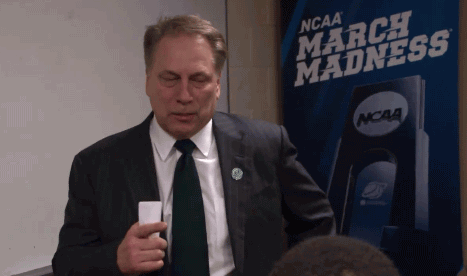
Tom Izzo's MSU teams are usually well-prepared for March
But some high school kids are frankly a little goofy and immature and just can't be 100% intense every practice. You're going to have an occasional practice where energy and attention levels are down and you want to just scream at them, or make them run.
We had an awful practice like that last week, the day before a big game. I was not optimistic. To my surprise, we came out with great energy for 32 minutes and won by 25-30 points!
So I think you have to figure out your own team. Maybe a "soft" practice is not always so bad, if they come out and play hard on game-night. A bad practice doesn't bother me as much as it used to, so long as we play hard on game night, and so long as bad practices don't become a habit.
Late-Season Practices
We treat the post-season tournament as a fun-time for the players. The season-long hard work is over. Players are usually in good physical condition by now. So late in the season, we shorten practices to 60-90 minutes. We do shooting drills and free-throws every practice. We scrimmage and go 5-on-5 up full-court for some aerobic work.At this point in the season, they should know your offenses and defenses, press offense and press defenses. We will however, drill a certain aspect or detail of any of these that needs attention. We might work on some late-game situations. We will quickly review some of our plays, and options.
We gear our practice toward our next opponent. If they play zone, we work on zone offense. If they press, we practice our press-breakers. We work on how to defend them.
But we don't want to be overly concerned about what our opponent might do. We want to focus on what we do, and let them worry about us. Making a big change, such as changing your defense from man-to-man to zone, or vice-versa, will usually cause more problems for you than your opponent. At this point, it's usually best to go with what you know you can do.
At the end of practice, we get a cheer and remind players to go home and get plenty of rest. They need their sleep to maintain health and energy, get over sicknesses, heal injuries, and to be good students.
We remind them to eat right, and avoid a lot of junk food. We also remind them to stay out of trouble and avoid making stupid, bad decisions that might get them benched, or kicked off the team.
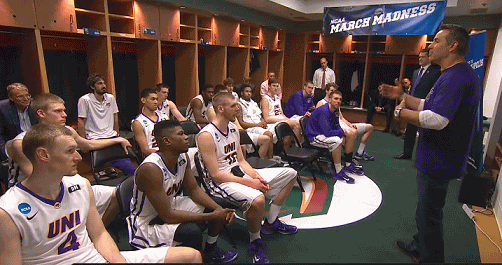
Adding new plays
We play our conference opponents twice during the regular season. By the end of the season, every coach in the conference knows what everyone else is doing on offense and defense. So we will add a few new plays for the post-season tournament.We purposely hold back a couple favorites and put them in just for the tournament. We usually add a couple new baseline out-of-bounds plays, a couple new half-court plays, and maybe a new sideline out-of-bounds play.
The plays that we select depend on our personnel. If we have a great outside shooter, we'll put in a play for him. A great post player... we look at something that will help us get the ball inside. A great point-guard... we'll try to stretch the defense and let him attack the seams with the dribble.
Go through the website's various plays (see Selecting Plays) and you'll be sure to find something for your team. Here are a few or our favorites.
"Kentucky"
"Kentucky-2" gets an open 3-point shot for our shooting guard O2. "Kentucky-3" is the same play and gets a shot for O3 instead. Kentucky-2 is run to the right side while Kentucky-3 goes to the left. We run these out of either a 3-out, 2-in or a 4-out, 1-in set."Kentucky-2"
This play gets O2 a 3-pointer. The play starts with a weave screen (diagram A) with O1 dribbling toward O2, handing off and screening for O2. Meanwhile, O5 cuts up to the weakside arc. O3 initially slides toward the corner (for spacing) but will eventually move back outside.O2 dribbles toward the point and passes to O5 (diagram B). For good spacing, it is important for O2 to dribble high to the top, even with the lane line. O4 screens for O1 who cuts around the screen, eventually out to the opposite corner. O5 could pass to O1 inside as our first early option. After screening for O1, O4 flare-screens for O2. It's key that this screen for O2 is set very high, in line with the right lane line, so that good spacing results for the flare pass to O2.
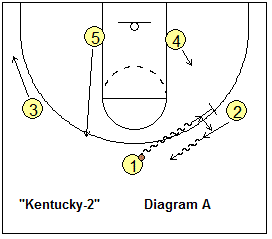
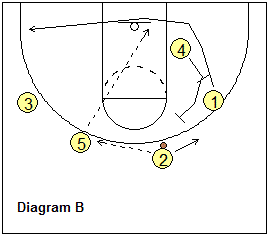
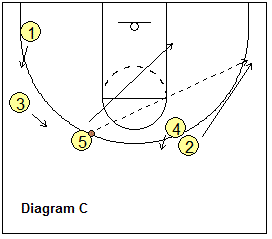
O2 cuts over the flare-screen to the wing-corner area (diagram C). O5 skips passes over the top to O2. After screening for O2, O4 rolls to the ball-side low post. O2 has the option of shooting the three-pointer, or passing inside to O4 in the low post. If the pass to O2 is denied, then O4 posts up inside and O5 makes the hi-lo pass to O4. Notice the weakside rotation after O5 passes to O2... O5 drops to the elbow, O3 rotates out to the point and O1 rotates to the left wing.
Another option is the "slip". After O2 hits a couple 3's, the defense may switch the O4-on-O2 flare-screen. If the defense switches, O4 slips the screen, and cuts hard through the lane to the hoop, for the pass from O5.
"Kentucky-3"
This is the same as "Kentucky-2" except to the left side. O1 dribbles left, hands off and screens for O3. O3 dribbles toward the top and passes to O4 who has moved to the top. O5 screens for both O1 and O3. O4 looks for O1 cutting inside, or for the over-the-top pass to O3. After screening for O3, O5 cuts to the ballside block. O5 could get the pass from either O3, or directly from O4 ("slip" option) if the defense switches the O5-on-O3 flare-screen.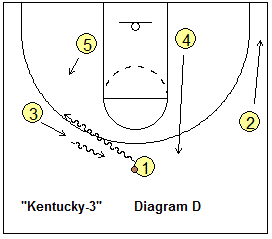
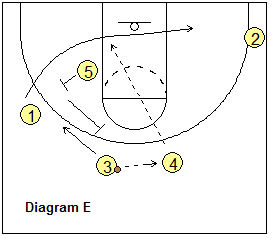
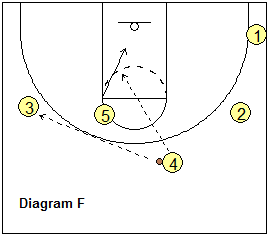
"Blitz" or "Big"
We really like this "hi-lo" play when we have a good strong inside post player. This is a great play also if the post's defender is in foul trouble as it exposes the defender to another potential foul. The "hi-lo" feed from the top works well as there is usually no inside helpside defense when the ball is at the top.See the diagram below. O1 dribbles toward the right wing as O2 starts in the corner. O4 moves to the top of the key and O1 passes to O4. O5 makes an aggressive post-up in the paint and O4 tries to make the hi-lo pass inside to O5. O5 scores or gets fouled. This is our first option. The pass from O4 to O5 must happen quickly to avoid O5 getting a three-second violation. Timing is important.
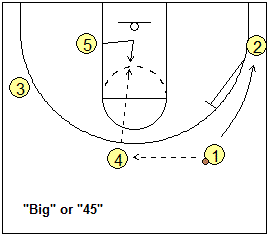
After O1 passes to O4, O2 flare-screens for O1, and O1 slides to the wing-corner area. If the pass inside to O5 is denied, O4 could skip-pass over the top to O1. O1 could shoot the three-pointer, or pass inside to O5 who posts up on the ballside as soon as the pass goes to O1. Another option when the hi-lo pass is denied is to have O4 fake a pass to O5, and make a quick dribble move to the hoop around the right side of the defender.
"15"
After you run Blitz a couple times, the defense may be looking for this play and may overplay and deny the pass from O1 to O4. In this case, O4 can simply backcut up the right side of the lane and get the pass from O1 for the lay-up. Another option is, instead of O1 passing to O4, O1 passes inside directly to O5 posting up. We call this option "15".
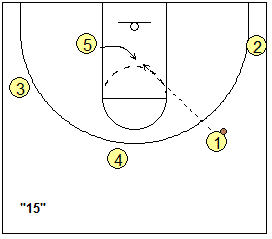
"Blitz-Left" or "Big-Left"
Run "Blitz" to the left side. O1 dribbles left and passes to O4. From here, the play is the same with O3 now flare-screening for O1. Another option is "Thumbs-Down" where we run the basic "Blitz" play, but O4 down-screens for O5. O5 comes up to the arc and gets the pass from O1 and now O4 posts up inside. It's the same as "Blitz", except O4 is your inside post player.
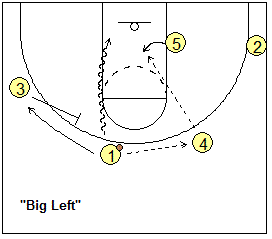
"15", "Blitz-Left" and "Thumbs-Down" are all just adjustments made to counter how the defense plays us.
Zone Plays - "Special" and "Special-Down"
See these two simple, effective zone plays to score inside vs the 2-3 zone defense.Out-of-Bounds Play "Box Wide-2" vs Man-to-Man Defense
Set-up in a box, with O5 wide. O2 cross down-screens for O1 (diagram A), and O1 cuts to the ball-side 3-point arc, as O2 then moves to the opposite corner. The inbounds pass goes to O1 (or could go to O5 and then out to O1).On the pass to O1, O5 screens for O3 and O3 cuts to the ball-side corner for a possible pass and 3-point shot (diagram B). If the defense switches the O5-O3 screen, O5 should get open by sealing the X3 defender and receive the pass from O1 for the inside shot. There could be a size mis-match here.
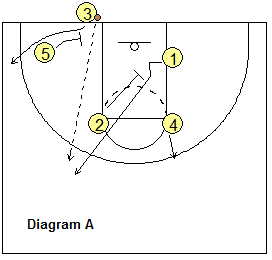
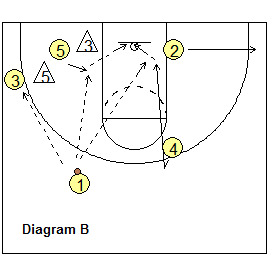
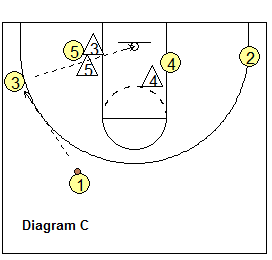
Now comes the fun part. After O1 receives the inbounds pass, O4 starts to cut up high calling for the ball. If the X4 defender overplays and denies, O4 quickly back-cuts to the hoop for the lob pass from O1 and possible dunk (O2 should have already cleared out to the corner). This option may not be open vs zones, but the previous options could be.
Out-of-Bounds Play "Splitter" - vs 2-3 Zone Defense
Diagram A. The defense is in a 2-3 zone. O3 is the inbounder. O1, O2, O4 and O5 stack, or line-up, along the ball-side lane. O5 lines up near the elbow... it's important that we start this stack high enough, to get good spacing. O4 stacks outside the X1 defender. O1 and O2 form a mini-stack above the X1 defender.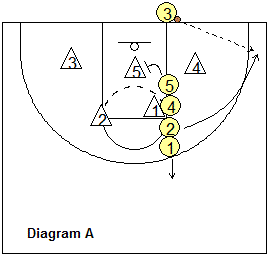
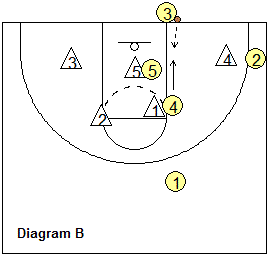
When O3 yells "go", O2 (your best shooter) cuts around O4's screen to the ball-side corner, calling for the ball. This should influence the outside low defender to move out to the corner to defend O2. O5 screens the middle, inside defender. If the X4 defender stays inside, O2 gets the pass for the 3-point shot (diagram A).
If the X4 defender to moves out toward the corner, O4 slides down the lane into the gap looking for the pass and shot (diagram B). You should have a 2-on-1 situation with the X4 defender. Either O2 or O4 should be open. O1 moves out of top as our safety.
Sideline Play, "Line-1"
Use this as a standard sideline play or a half-court, buzzer-beater with just a few seconds left. O4 starts low and sprints up to receive the pass from O3. Meanwhile, O1 screens for O2 and after screening, cuts hard to the back-side elbow for a quick pass from O4 and the shot, or lay-up, depending on how much time is left. After inbounding the ball, O3 cuts to the left wing and could also get the pass and last-second shot. If both wings are covered, O4 may have to take the shot. If time is not a factor, O2 is our safety pass in the back-court.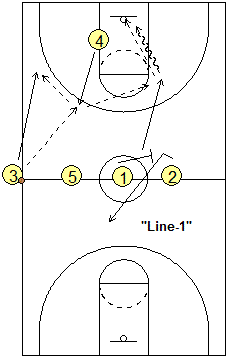
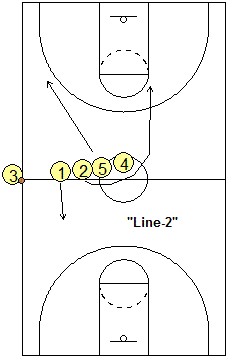
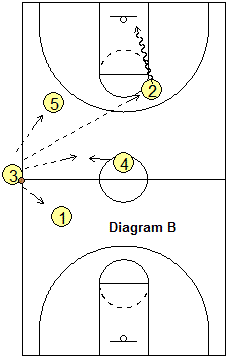
Sideline Play, "Line-2"
This sideline play also uses a line set (see diagrams above), and tries to get an inbounds lob pass to O2 going to the hoop. Change this to fit your own personnel. O1 cuts into the back-court as our safety outlet. O2 cuts hard around O5 and O4. O3 looks to make the lob pass over the top to O2 cutting to the hoop. After O2 cuts, O5 moves to the ball-side wing and O4 cuts straight toward the ball. If the pass goes to O1, O5 or O4, then just set up in your usual half-court offense.Winning Tournament Games
To make a tournament run, your team must come together, gelling at the right time. They must play hard for 32 minutes each game, and play together. They have to "play to win", and not "play not to lose", which means they can't worry about winning and losing, and making mistakes and missing shots. They just play as hard as they can, with every player doing his job, and have fun. Key players must avoid getting into foul-trouble.Big tournament wins and upsets are usually the result of the underdog team playing tenacious defense, and out-hustling and out-rebounding the favored team.
In tournament time, don't rely night after night on winning with 3-point shooting, because when you have an off-night shooting, you're done. Attack the rim, get the ball inside and get to the free-throw line.
Advise players that pre-game jitters is normal and a good thing. They can use that nervous energy early in the game to play tough, hard pressure defense, hustle and dive after loose balls, and be aggressive on the boards for rebounds. As the saying goes, "it takes no talent to hustle." If you do the hustle things well, your offense will usually fall into place too. On offense, make the easy pass and avoid turnovers.
Some coaching strategy: finish the quarter with the last shot if you can, especially if you have the possession arrow for the next quarter. This could result in back-to-back baskets for you. Coach Bob Knight has pointed out the importance of finishing well the last 4 minutes of the first half, and the importance of starting well the first 4 minutes of the second half.
Related page: